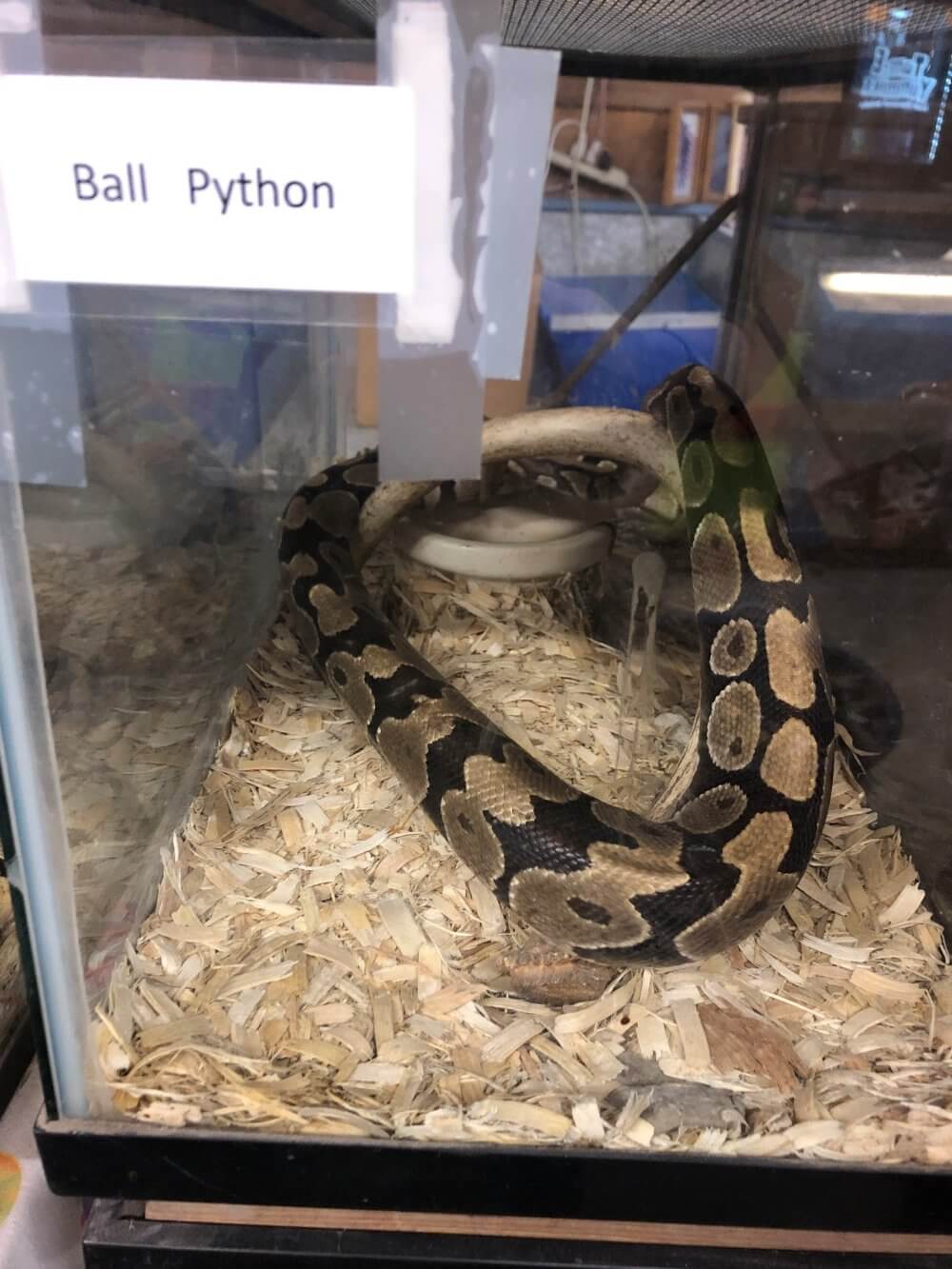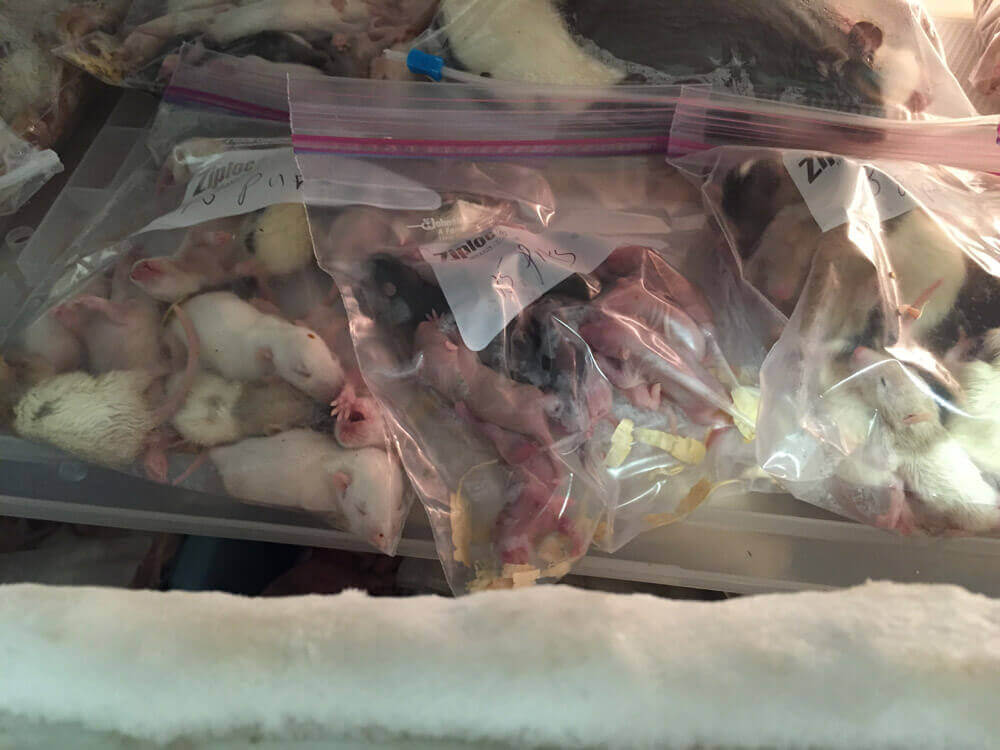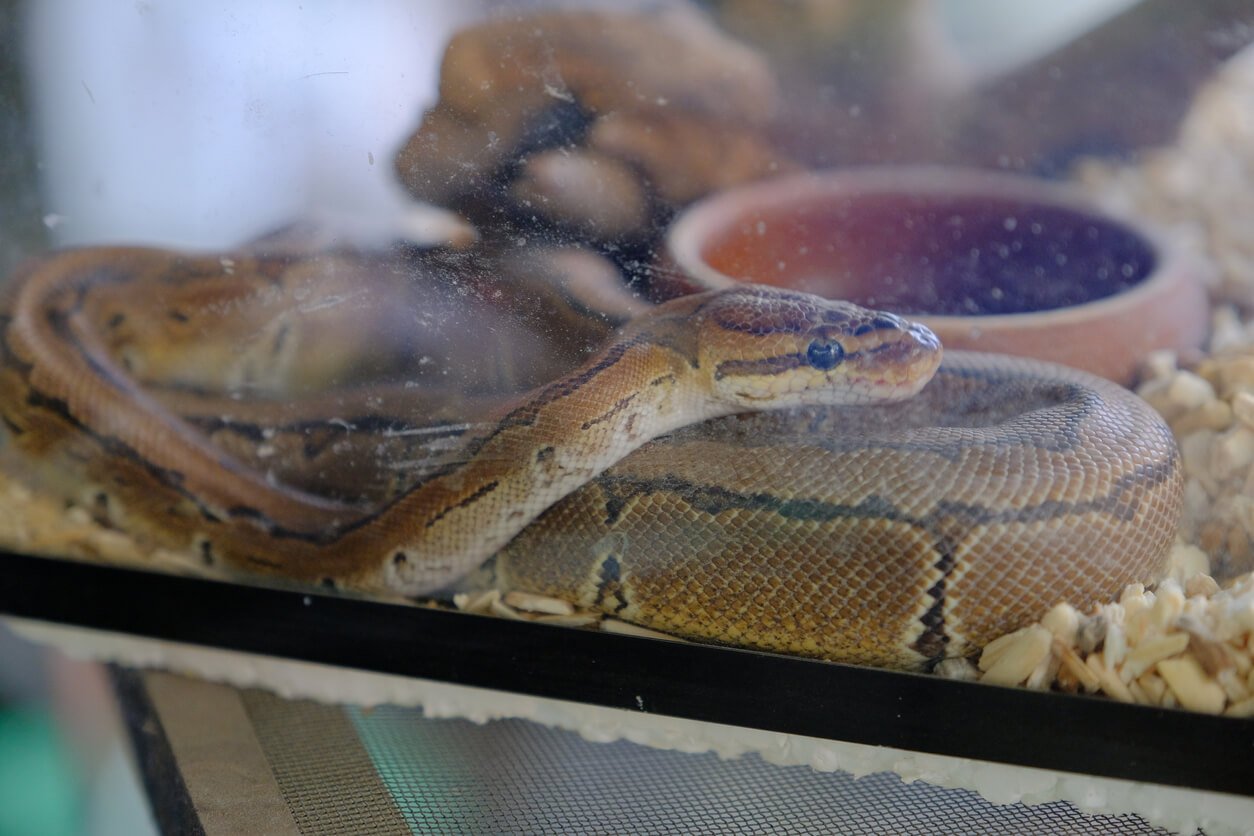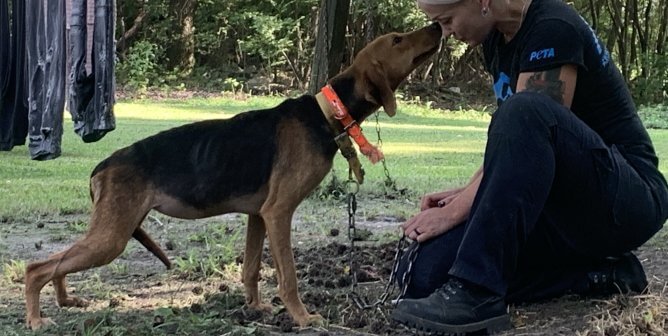Are you thinking of buying a snake? First things first—it’s never OK to buy or sell another sentient being. It’s one thing to adopt a homeless animal who depends on humans, but that’s not usually the case with snakes. Many reptiles sold as “pets” are captured in their natural homes and then shipped to other continents and sold by an industry that handles these sensitive and fragile animals as if they were car parts. Others are bred in massive mills where their needs are disregarded and their instincts to engage in natural behavior are thwarted.
There are no good reasons for buying a snake, but here are nine good ones not to:
1. The pet trade is abysmal.
Snakes sold as “pets” come from places like U.S. Global Exotics (USGE), which—at the time of PETA’s investigation—was the nation’s largest global supplier of exotic animals to the pet trade, including intermediaries with ties to Petco and PetSmart. USGE confined tens of thousands of animals in its facility, where only a few staff members were employed to “care” for them. Many of the snakes were caught in nature and shipped from all over the world to USGE, where they were kept in shoebox-size containers or extremely crowded troughs. PETA revealed that every day, many perished from untreated illnesses, infections, or injuries and that many experienced seizures. They were confined to severely crowded and filthy enclosures and denied the most basic necessities, including food, heat, adequate space, and even water. Workers put hundreds of snakes in a freezer and left them to die.
The suffering at USGE is not an anomaly. During a PETA investigation into a California dealer called Global Captive Breeders (GCB), snakes and other reptiles were so neglected that workers rarely noticed when they had died. Enclosures—little more than plastic shoeboxes—were filled with rotting carcasses teeming with maggots.
PETA’s investigation led to the seizure of more than 600 reptiles and nearly 16,000 rats from this hellhole, but many other pet-trade operations still profit from animal exploitation and suffering just like this.
2. No captive environment can compare to snakes’ natural habitats.
In their natural habitats, these complex animals warm themselves in the sun, burrow underground, swim, climb trees, and travel long distances. They mate when they want to and go solo when they feel like it. All these natural types of behavior are impossible to engage in inside cramped, solitary glass terrariums, like the too-small, almost barren ones peddled by Zoo Med Laboratories, Inc., and other companies and sold in retail pet stores.
3. Snakes aren’t “starter pets.”
While the captive-reptile industry—Zoo Med included—continues to market snakes inaccurately as “beginner companions” or “starter pets,” in reality, they are high-maintenance animals who deserve respect and compassion. You can start by leaving them alone.

There are 3,000 species of snakes in the world, and it’s estimated that over a million snakes are kept captive as “pets” in the U.S. Experts believe that more than 70% of snakes and other exotic animals in the pet trade die before they even reach stores. According to one study, 75% of “pet” reptiles, including snakes, die within one year—many from stress related to captivity. This shows how difficult it is to meet their complex needs in captivity.
4. Snakes have specific needs that are nearly impossible to meet in captivity.
Even though snake dealers looking to make a profit may downplay the many needs of captive reptiles, snakes require spectrum lighting, specific temperatures and humidity levels, precise diets and feeding schedules, and lots of space. Taking adequate care of a snake is a nearly impossible and very expensive endeavor. In one survey, veterinarians estimated that 47% of the exotic “pets” (including snakes) brought to them didn’t have their needs met and 89% of those surveyed said that these animals most often lack a suitable environment.
Snakes won’t be receptive to your affection—they’re wary animals who don’t like being held, touched, petted, or passed around. It’s stressful for them and puts them at risk of illness and injury, and because they don’t whine or yelp, you may not realize that they’re hurt. (See reason number 7.)
5. Buying small animals to feed a snake supports the cruel pet trade, even if you adopt a snake.
Even if you adopt a snake, there’s no getting around the fact that they eat rabbits, rats, mice, and other small animals who are typically bought from pet stores. Multiple PETA investigations into Petco and PetSmart suppliers uncovered horrors, including that live rats were stuffed into plastic bags and put in a freezer, where they were left to suffocate and freeze to death slowly—even as some frantically tried to claw their way out.

Many of these animals were later sold as food for snakes and other reptiles. During nearly three months at one facility, PETA’s observer found hundreds of small animals dead, often in bins, where no water was available.
6. Having a snake doesn’t make you look edgy—just foolish.
Salmonella, which can result in septicemia (blood poisoning), and other bacteria that can cause disease in humans are commonly found in snakes and other reptiles. Your snake can pass along botulism (which can lead to paralysis and death), campylobacteriosis (bowel infection), trichinellosis (muscle, nervous system, heart, and lungs disease), and leptospirosis (liver disease). It’s not edgy to get diarrhea, abdominal pain, fever, or life-threatening illnesses from a reptile you chose to have contact with for no good reason.
Relegating a snake to a glass prison cell isn’t impressive. Learning to play an instrument, making your own vegan cheese, or speaking another language—that’s impressive.
7. Not only can snakes make you sick, you can also make them sick.
It’s not uncommon for “pet” snakes to suffer from infectious stomatitis (mouth rot), internal and external parasites, skin infections, diarrhea, breathing difficulties, inclusion body disease, regurgitation, vomiting, organ swelling, anemia, weight loss, respiratory disease, or septicemia. Do you know what symptoms to look out for? Will you be able to afford treatment?
8. Snakes have feelings.
Many species of snakes are protective mothers, and some don’t let their young out of their sight for three weeks after they’re born or hatched, even though baby snakes are fully capable of hunting and defending themselves.
Imagine being forced to spend your life in a tank that’s shorter than the length of your body. When snakes are kept this way, it causes them anguish and trauma. Just like humans and other animals, they need to be able to stretch out to their full length—at the bare minimum—and they need exercise and room to move.

9. Snakes have rights.
Animals don’t want to be your “pet.” They are conscious, free-willed individuals who can form meaningful relationships, and they have thoughts, preferences, memories, and problem-solving skills. Putting your desire to “own” a snake above their need for freedom is speciesist. Every animal has the right to live free from human exploitation.
Animal companions must be treated with respect and be allowed to lead a fulfilling and dignified life in which all their needs are met—and that means not buying snakes or other animals to keep as “pets.”
You can help snakes and other reptiles.
Never buy a snake or any other animal from a pet store or breeder, and ask friends and family not to support this deadly industry, either.
If you were misled into purchasing a habitat for a snake or another reptile that didn’t meet their most basic needs—such as being able to stretch out, burrow, or climb—please contact us.







